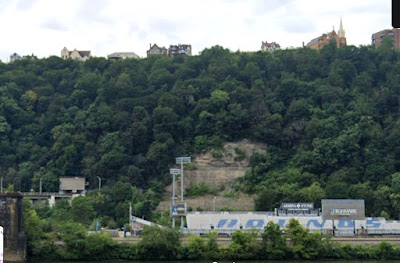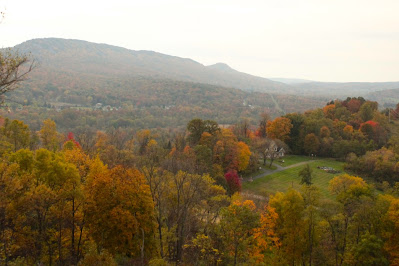I had just finished reading “The Cartographers” by Peng Shepard
and was thinking about it. It was about maps and how they have the potential
for making places real. While the book was about using a map as a key to
entering a place no one else could go to unless they held the map, I’ve always
thought that maps made things real to us. By showing us the way to go, we can
experience places that we’ve only heard about.
Every time I go on a trip, or even think about
the possibility of going on one, I go to my maps. Atlas’s, gazetteers, simple
folded gas station maps, (remember those?) and even the simple to use, internet
maps, I use them all. Looking at them I can decide which routes to take, I can
determine whether it will be a quick speedy journey or a scenic one. I can find
places to stop and places where things can be found and uncovered. Maps are as
important to me as my books are!
I recently saw a picture of an old furnace that someone had
posted. My curiosity piqued, I pulled out my reference materials.
The first step was to check a book I have about iron
furnaces. Published during the second half
of the last century, A Guide to the Old Stone Blast Furnaces in
Western Pennsylvania, written by Myron Sharp and William Thomas, has
been invaluable to me, helping me find numerous old furnaces. Some were mere
piles of rock, a few were empty fields or parking lots but there have also been
a lot of exciting structures found. Some are hidden deep in the woods, inaccessible
to anyone except those who don’t mind a bit of discomfort in their exploring.
Some are sitting in plain sight beside the road. This book has taken me to
numerous furnaces which while being over 100 years old, still show the mastery
of the men who put them together!
With a little more information about the furnace, I turned next to my Pennsylvania Gazetteer and tracked down the roads mentioned in the
book. I also checked a couple other books I have to see if there was any
mention of the furnace in them. I added more notes to my list and then I
moved into the present century and the computer.
I visited a favorite search site called Waymarking.com. They
have a category called Iron Furnace Ruins which consists of seven pages of
furnaces located around the world. I quickly found the furnace I was thinking
about going to and clicked on it. I was presented a couple pictures and a GPS
location! I copied them all. I put a mark on a map indicating where it was
located.
With Google Maps, I had a good idea of what the countryside
looked like, the satellite view showed me near-by road marks, places which
would help keep me on track. On-line
topographic maps helped me see what kind of hills and valleys I might
encounter.
I also searched the maps on Geocaching.com to see if there
were any hides in the area. A new cache had been listed at a site that I had
visited before, near another iron furnace. Located with-in 10 miles of the other, as
the crow flies, I added it to the list also!
I compared maps and made a route which would take us on a
nice, scenic route, making sure to pass a few geocaches on the way. I avoided
any toll roads and we would only take one expressway for about 5-10 miles. The
ride would be an enjoyable one!
On Thursday morning, I had my gear packed in the car and was
enjoying a cup of coffee when Frank arrived. A bit earlier than planned but
that was expected, neither of us has a problem with early starts. We hit the
road well before the sun rose. Our first geocache was found with the aid of a
flashlight. Soon after, the sky in the east started showing its colors.
We made a brief photo stop at the Country Kitchen, its egg
showing up nicely in the predawn light. A couple caches later, we hit route 80,
just a little after 8. The slanting sunshine of the morning gave the trees even
more color, making the ride a visual experience.
We were getting closer, the Alleghany River had a slight
covering of mist on it as we crossed it into Emlenton, then we headed back up
out of the river valley to the hill tops.
We found another cache less than a mile away from the
furnace. Hidden on a small open grate bridge, it gave us another opportunity to
get out and stretch our legs as we were looking. We signed the log and re-hid
it and then drove another quarter mile where we encountered a gate. Parking
here, we slung our camera gear over our shoulders and proceeded on foot. The
trail was a gravel/ dirt road, going on a slight uphill slant before dropping
down into the valley. Going down, we could see the road leveling off ahead of us and as we
rounded a curve, our GPSs told us we had arrived.
A slight rise in the surrounding weeds was all we could see,
the sunlight coming from behind the furnace further hid the structure from us.
We took a “path” which led towards where we thought it would be. As we pushed
through waist high weeds and crossed over hidden fallen trees the stones of the
structure started to appear to us.
Surrounded by the weeds and bushes it was hard to get a
whole view of the furnace. Vines grabbed at our feet and thorns tore at our
clothes and skin. We couldn’t see where we were planting our feet, we could
only guess and hope.
Finally, there it was, the Webster Furnace. It was built
back in 1838 and operated for an unknown amount of time. It went out of blast
when the owners went bankrupt. What makes this furnace exciting is that the
base is square like most furnaces, but the top portion has an octagonal shape
covering the chimney, an eight-sided top!
The furnace is in fairly good shape but trees have grown on
top of it and their roots are slowly pushing the blocks apart, leading to its eventual
demise. The underbrush made it difficult moving around it and seeing anything
such as a mill race or walls, if there were any.
After my photographic lust had been quenched, we packed up
and started back up the hill. It was only seven tenths of a mile but it seemed
to me to be further on the way up!
We drove through the picturesque town of Franklin and
stopped for two more caches before heading back towards home. The first was a failure;
we couldn’t locate it and after a few minutes, continued on the final cache.
Sometimes you’re lucky and sometimes, you just strike out…
The second cache was great, in my opinion. We parked alongside
the road and had to crawl over a deer fence. This put us at the top of a semi-deep
valley. Most of the hillside was steep but there were a couple ramps which
allowed access. Crossing a small stream, the furnace slowly revealed itself,
sitting among the yellow fall leaves, hidden in plain sight.
This was the Victory Furnace, built in 1843 and worked for
about 7 years before it went out of blast. It is a nice tall furnace, the edges
still sharp and square but it does have a few big cracks in it, one large one
going up its front. I passed some cut rocks as I approached, possibly from the
millrace or some other structures. There are supposedly ruins of the charcoal
house on the hill behind it, I didn’t climb up to see but the idea of another trip has
started to grow in my mind! Perhaps when the leaves have fallen and the sight
lines are better.
This wasn’t the first time I had visited the Victory
Furnace. My first visit was because of another geocache. I stopped here early
in the morning on a cool fall day in 2008. The valley was filled with fog and
the sun was just rising, the area was dark, but that wasn’t going to stop
me. It was a day that caused my imagination to wander.
At the bottom of the hillside, I came to the stream. It had
steep banks and I had to look around to find a place where I could get down to
the water level. Splashing across the shallow stream, my GPS showed the cache
only 50-60 feet away. Scrambling up the steep bank, the furnace revealed itself
to me. Coming out of the fog, it resembled an ancient temple, much like in an
Indiana Jones movie. With my heart beating and adrenalin pounding through my
veins, I made my way through the fog and the weeds to the base of the furnace.
Sitting alone in the valley, it appeared as if it had been
dropped here. There were no roads or trails that I could see and no signs of any other
ruins near-by. It was a mystical experience and the worst thing about it was
that there was no one with me to share it with. It was one of those days that I’ll
never forget!
After spending some time finding the cache and taking
pictures, Frank and I re-climbed the hill and returned to the car. In my mind, this was
the best cache of the day! In another hour (or so) we were back at my house.
Frank continued on to his home and I went in to change out of my dirty clothes
and look for ticks. (none found!)
I looked at my pictures and got a bite to eat and then sat
down and started thinking…when could I go back to that last furnace?
I already
have the maps…













.jpg)



.jpg)





.jpg)




